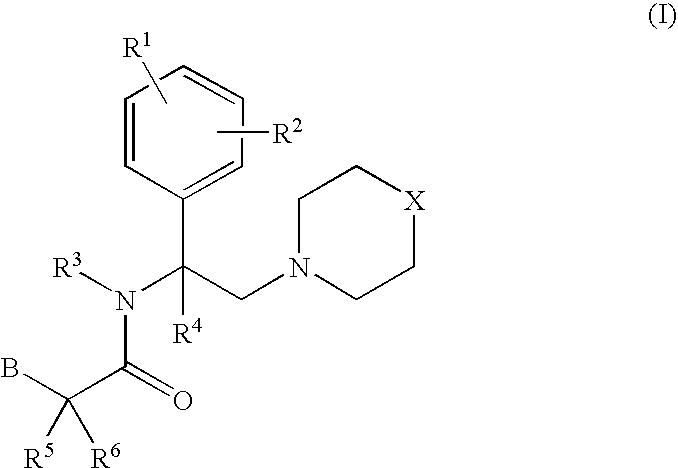Morpholinyl and pyrrolidinyl analogs
a technology of pyrrolidinyl and morpholinyl, which is applied in the field of morpholinyl and pyrrolidinyl analogs, can solve problems such as pathological consequences of cardiac hemodynamic dysfunction
- Summary
- Abstract
- Description
- Claims
- Application Information
AI Technical Summary
Benefits of technology
Problems solved by technology
Method used
Image
Examples
example 1
N-(3,4-dichlorophenyl)-N-methylglycine, lithium salt
[0377]
a) Ethyl N-(3,4-dichlorophenyl)glycinate
[0378]
[0379]3,4-Dichloroaniline (100 g, 0.617 mol), ethyl bromoacetate (68.4 mL, 0.617 mol), and diisopropylethylamine (129.0 mL, 0.740 mol) were combined in 300 mL of dry NMP and stirred at room temperature for 18 h. HPLC (Eclipse XDB-C 18, 4.6×250 mm, 5 micron, 1-99% CH3CN / H2O with 0.1% trifluoroacetic acid) after 18 h at room temperature showed that most of the starting material (Rt=5.2 min) was consumed and that a new peak had formed (Rt=7.9 min). The reaction was heated to 90° C. for 1 h, at which point HPLC indicated that conversion was complete. The reaction was allowed to cool to room temperature and then poured onto 2.5 L of ice, 1.5 L of water, and 240 g of NaHCO3. A tan precipitate formed immediately, the suspension was stirred vigorously for 10 minutes and then filtered through a fritted glass funnel. The tan solid was air-dried for 20 h in a crystallizing dish and then tran...
example 2
((3,4-Dichlorophenyl){2-oxo-2-[(cis)-3-phenyl-2-(1-pyrrolidinylmethyl)-1-piperidinyl]ethyl}amino)acetonitrile
[0384]
a) Ethyl N-(cyanomethyl)-N-(3,4-dichlorophenyl)glycinate
[0385]
[0386]Ethyl N-(3,4-dichlorophenyl)glycinate (4.0 g, 16.1 mmol), diisopropylethylamine (3.37 mL, 19.3 mmol), bromoacetonitrile (1.23 mL, 17.7 mmol) and sodium iodide (2.41 g, 16.1 mmol) were dissolved in 25 mL of dry NMP and heated to 120° C. After 20 h, HPLC (Eclipse XDB-C18, 4.6×250 mm, 5 micron, 1-99% CH3CN / H2O with 0.1% trifluoroacetic acid) showed that approximately half of the starting material (Rt=7.8 min) was consumed and that a new peak had formed (Rt=7.6 min). The reaction was monitored periodically by HPLC and additional bromoacetonitrile was added as needed to achieve complete conversion. In this case, an additional 1.5 equivalents (1.68 mL, 24.1 mmol) of bromoacetonitrile was added and the reaction was heated for an additional 28 h, after which time the HPLC indicated that the reaction was complet...
example 3
(6,7-dichloro-3-oxo-2,3-dihydro-4H-1,4-benzoxazin-4-yl)acetic acid
[0389]
a) ethyl [(4,5-dichloro-2-nitrophenyl)oxylacetate
[0390]
[0391]1,2-dichloro-4-fluoro-5-nitrobenzene (50 g, 0.238 mol), ethyl glycolate (90.1 mL, 0.952 mol), and potassium fluoride (76.1 g, 1.31 mol) were added to a 1L round-bottom flask containing 200 mL of anhydrous dioxane. The mixture was magnetically stirred and heated to 100° C. in an oil bath. After two hours, HPLC (Eclipse XDB-C18, 4.6×250 mm, 5 micron, 1-99% CH3CN / H2O with 0.1% trifluoroacetic acid) showed that all of the starting material (Rt=7.5 min) was gone and that one major peak (Rt=7.8 min) had formed. The reaction mixture was poured into 4 L of water, which resulted in precipitation of the product. The solid was filtered off and dried under vacuum to give ethyl [(4,5-dichloro-2-nitrophenyl)oxy]acetate (67.4 g, 0.229 mol, 96%) as a tan solid. MS (ES) m / e 294 [M+H]+.
b) 6,7-dichloro-2H-1,4-benzoxazin-3(4H)-one
[0392]
[0393]Ethyl [(4,5-dichloro-2-nitroph...
PUM
| Property | Measurement | Unit |
|---|---|---|
| pH | aaaaa | aaaaa |
| temperature | aaaaa | aaaaa |
| temperature | aaaaa | aaaaa |
Abstract
Description
Claims
Application Information
 Login to View More
Login to View More - R&D
- Intellectual Property
- Life Sciences
- Materials
- Tech Scout
- Unparalleled Data Quality
- Higher Quality Content
- 60% Fewer Hallucinations
Browse by: Latest US Patents, China's latest patents, Technical Efficacy Thesaurus, Application Domain, Technology Topic, Popular Technical Reports.
© 2025 PatSnap. All rights reserved.Legal|Privacy policy|Modern Slavery Act Transparency Statement|Sitemap|About US| Contact US: help@patsnap.com



